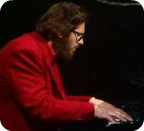Rifftides: September 2010 Archives
Jazz is dying? Ha. The stacks of evidence on my office floor say otherwise.
Here you see a few of the recent arrivals.
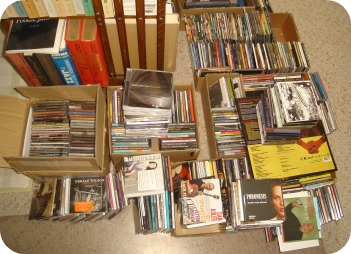 As I may have mentioned, it is impossible to keep up with this stuff. No matter how many listening hours the reviewer carves out of the day, they can never be enough. Selectivity is a necessity. In this installment of the never-ending attempt to stay abreast, here are the Rifftides staff's impressions of a few more or less new releases. These are not full-fledged—even half-fledged—reviews. Let's call them alerts to worthwhile listening, with brief observations.
As I may have mentioned, it is impossible to keep up with this stuff. No matter how many listening hours the reviewer carves out of the day, they can never be enough. Selectivity is a necessity. In this installment of the never-ending attempt to stay abreast, here are the Rifftides staff's impressions of a few more or less new releases. These are not full-fledged—even half-fledged—reviews. Let's call them alerts to worthwhile listening, with brief observations.
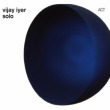 Vijay Iyer, Solo (ACT). The pianist takes chances with every aspect of time, harmony and melody. He has the imagination, technique and understanding of the jazz piano tradition to bring off his adventuring with coherence and a sense of discovery. Two Ellington pieces, Monk's "Epistrophy" and "Darn That Dream" give the listener familiar guideposts, but you may find yourself going back to the magnetic complexities of Iyer's "Autoscopy."
Vijay Iyer, Solo (ACT). The pianist takes chances with every aspect of time, harmony and melody. He has the imagination, technique and understanding of the jazz piano tradition to bring off his adventuring with coherence and a sense of discovery. Two Ellington pieces, Monk's "Epistrophy" and "Darn That Dream" give the listener familiar guideposts, but you may find yourself going back to the magnetic complexities of Iyer's "Autoscopy."
Rebecca Kilgore Quartet, Yes, Indeed (Blue Swing). Kilgore doesn't get the recognition she deserves as one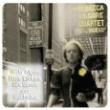 of our finest singers, regardless of category. This collection of standards with her quartet formerly known as B.E.D. could help change that. Kilgore, guitarist Eddie Erickson, trombonist Dan Barrett and bassist Joel Forbes display the polish and tightness of years' experience together. Kilgore's poise, perfect intonation and phrasing are central, but Erickson sings charmingly and Barrett is superb on trombone and cornet. A highlight: the aching purity of Kilgore's vocal on "I Wish I Knew."
of our finest singers, regardless of category. This collection of standards with her quartet formerly known as B.E.D. could help change that. Kilgore, guitarist Eddie Erickson, trombonist Dan Barrett and bassist Joel Forbes display the polish and tightness of years' experience together. Kilgore's poise, perfect intonation and phrasing are central, but Erickson sings charmingly and Barrett is superb on trombone and cornet. A highlight: the aching purity of Kilgore's vocal on "I Wish I Knew."
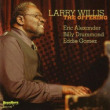 Larry Willis, The Offering (High Note). In demand over the years by leaders as various as Jackie McLean, Stan Getz and Roy Hargrove, pianist Willis recruits tenor saxophonist Eric Alexander, bassist Eddie Gomez and drummer Billy Drummond for this all-star session. His broad expressive and dynamic ranges are impressive throughout, nowhere more than in "Ethiopia," in which Gomez also shines. Willis's Bill Evans leanings are evident in "Three-Four Movement." It's a surprise to find the theme from Star Trek on a jazz album, but it works for improvisation and inspires splendid solos by Willis and Alexander.
Larry Willis, The Offering (High Note). In demand over the years by leaders as various as Jackie McLean, Stan Getz and Roy Hargrove, pianist Willis recruits tenor saxophonist Eric Alexander, bassist Eddie Gomez and drummer Billy Drummond for this all-star session. His broad expressive and dynamic ranges are impressive throughout, nowhere more than in "Ethiopia," in which Gomez also shines. Willis's Bill Evans leanings are evident in "Three-Four Movement." It's a surprise to find the theme from Star Trek on a jazz album, but it works for improvisation and inspires splendid solos by Willis and Alexander.
Amina Figarova, Sketches (Munich). Figarova is almost certainly the only Azerbaijani jazz pianist and composer to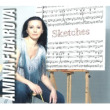 make an impact in the United States. The fleetness and depth of her playing are matched by her writing. She manages to invest three horns with harmonic fullness that often makes her sextet sound half again bigger. Her music has refined relaxation, as in "Four Steps to...," the tongue-in-cheek playfulness of "Breakfast for the Elephant" and the intensity of "Flight No." Figarova is a musician of originality, one to watch.
make an impact in the United States. The fleetness and depth of her playing are matched by her writing. She manages to invest three horns with harmonic fullness that often makes her sextet sound half again bigger. Her music has refined relaxation, as in "Four Steps to...," the tongue-in-cheek playfulness of "Breakfast for the Elephant" and the intensity of "Flight No." Figarova is a musician of originality, one to watch.
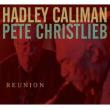 Hadley Caliman, Pete Christlieb, Reunion (Origin). This was the last record Caliman made before he died early this month. It brought him together with fellow tenor saxophonist Pete Christlieb, with whom he played in Los Angeles in the early '60s when Caliman was a young veteran and Christlieb a stripling. Their empathy, and the contrast in their styles, rekindles in this affectionate, spirited collaboration. The CD includes compositions by each, a lovely "Up Jumped Spring" and a high-energy romp on "Love for Sale." Pianist Bill Anschell, bassist Chuck Deardorf and drummer John Bishop are the yeomanly rhythm section.
Hadley Caliman, Pete Christlieb, Reunion (Origin). This was the last record Caliman made before he died early this month. It brought him together with fellow tenor saxophonist Pete Christlieb, with whom he played in Los Angeles in the early '60s when Caliman was a young veteran and Christlieb a stripling. Their empathy, and the contrast in their styles, rekindles in this affectionate, spirited collaboration. The CD includes compositions by each, a lovely "Up Jumped Spring" and a high-energy romp on "Love for Sale." Pianist Bill Anschell, bassist Chuck Deardorf and drummer John Bishop are the yeomanly rhythm section.
More In Breve soon. Watch this space.
Danilo Pérez, Providencia (MackAvenue).
In what may well have been his most substantial and visionary contribution to world understanding and the progress of his nation, the late Mexican president José López Portillo said in a 1977 interview, "Everything is part of everything else." 1,500 miles to the south in Panama, Danilo Pérez was an 11-year-piano student. He may not then have been paying attention to the international relations pronouncements of foreign politicians, but when it comes to music, the adult Pérez is in agreement with the López Portillo principle. Providencia presents his philosophy in a program of 11 pieces that in an era of conflict and baffling change is intended to break through categories into a unitarian vision. Listeners may approach the CD with that in mind and be inspired by Pérez"s world view. Or they may disregard the programmatic scheme announced in the liner notes and enjoy a collection that, for the most part, works with or without a message.
principle. Providencia presents his philosophy in a program of 11 pieces that in an era of conflict and baffling change is intended to break through categories into a unitarian vision. Listeners may approach the CD with that in mind and be inspired by Pérez"s world view. Or they may disregard the programmatic scheme announced in the liner notes and enjoy a collection that, for the most part, works with or without a message.
However global Pérez's intention, the heart of his music remains in the Central American conventions that formed his ethos. The CD is a successor to previous Pérez albums, Panamonk and Motherland. It develops elements of his work that go back to the 1993 debut recording named for him. His writing and playing here are at their most moving when they try least hard. Two traditional pieces, "Historia de un Amor" and "Irremediablemente Solo," with his longtime bassist Ben Street and drummer Adam Cruz, are langorous exercises in trio empathy and melodic development. In several tracks, alto saxophonist Rudresh Mahanthappa, Pérez and the trio explode with emotion. Elsewhere, ensembles employing woodwinds meander, although a section of one with a vocalese lead by soprano Sara Serpa crystallizes to great effect. The album ends with a short duet between Pérez and Mahanthappa that gleams with elegance and longing.
The pianist, composer and teacher Joan Stiles runs one of the hippest sextets in New York. Her circle of insider admirers encompasses many of the best-known musicians in  jazz today and is widening to include a substantial number of listeners in the general audience. Stiles achieves identifiable individuality in her own compositions and in her arrangements of songbook standards and pieces by Mary Lou Williams, Thelonious Monk, Fats Waller, Jimmy Rowles and Duke Ellington, among others.
jazz today and is widening to include a substantial number of listeners in the general audience. Stiles achieves identifiable individuality in her own compositions and in her arrangements of songbook standards and pieces by Mary Lou Williams, Thelonious Monk, Fats Waller, Jimmy Rowles and Duke Ellington, among others.
Stiles was the most recent guest on Marian McPartland's Piano Jazz on National Public Radio, with Jon Weber subbing for McPartland. She plays several unaccompanied pieces, including her impressions of Monk on "Spherical," and a few with Weber on bass. NPR streams the program on the web at this address. Go there and click on "Listen Now."
Stiles' sextet is truly all-star: Jeremy Pelt, trumpet; Steve Wilson, alto saxophone; Joel Frahm, tenor saxophone; Ben Williams, bass; and Lewis Nash, drums. The only videos I've been able to locate of the band are mostly short, made at the Iridium in New York with a static camera that sometimes excludes Stiles and a microphone that could be closer to the piano. Nonetheless, a couple of them will give you the flavor of the band and of Stiles' soloing. The first features Pelt. The second is the title track of her most recent CD, Hurly Burly.
Why that was cut short, I have no idea. "Hurly Burly" in its entirety is on this album. Full disclosure: I wrote the liner notes for it a couple of years ago. And I'd do it again. Stiles is gaining recognition and deserves it.
Jack Reilly, Live At Maybeck Recital Hall (Unichrom). Maybeck is a small hall in Berkeley, California, loved by pianists and listeners for the perfection of its acoustics. Carl Jefferson of Concord Records was so taken with the sound of the room that he initiated a series of 42 solo piano recordings there. It began with Joanne Brackeen in 1989 and ended with James Williams in 1995. In between is a variety of the finest pianists in jazz, among them Dick Hyman, Jaki Byard, Ellis Larkins, Jessica Williams, Hank Jones and George Cables. After pianist Dick Whittington bought Maybeck, but before Concord discovered it, Jack Reilly was one of the first artists who played there, so he is not included in the series. That is a pity, because Reilly's Maybeck concert equals the best of the Concord Maybeck albums.
All is not lost, however. Reilly recently discovered that his 1988 concert existed on a cassette tape. He concluded that it was some of his best playing and decided to release 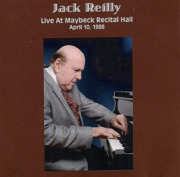 it on Unichrom, his private label. The transfer to CD may not bring the sound up to 2010 digital perfection, but it is entirely listenable. The slight sandpaperiness around the audio edges does nothing to obscure Reilly's virtuosity and creativity. Into a program of jazz and classical pieces he pumps energy, imagination and—in some cases—swing that is almost physically palpable. His program encompasses Cesar Franck, Chopin, Ravel, Strayhorn, Ellington, Gershwin, Bill Evans and two of his own compositions. His opening piece is the Franck "Prelude, Chorale and Fugue," performed with subtlety, power and fidelity to the composer.
it on Unichrom, his private label. The transfer to CD may not bring the sound up to 2010 digital perfection, but it is entirely listenable. The slight sandpaperiness around the audio edges does nothing to obscure Reilly's virtuosity and creativity. Into a program of jazz and classical pieces he pumps energy, imagination and—in some cases—swing that is almost physically palpable. His program encompasses Cesar Franck, Chopin, Ravel, Strayhorn, Ellington, Gershwin, Bill Evans and two of his own compositions. His opening piece is the Franck "Prelude, Chorale and Fugue," performed with subtlety, power and fidelity to the composer.
Reilly introduces jazz to the concert when he melds Chopin's C-major Prelude with "Take the 'A' Train" and the Chopin G-minor Prelude with "It Don't Mean a Thing if it Ain't Got That Swing." The commonality he finds in Chopin and Strayhorn, Chopin and Ellington, corroborates Ellington's famous dictum that there are only two kinds of music—good music and the other kind. Reilly makes a medley of a Ravel minuet and three Evans pieces, incorporating stride passages into "Waltz for Debby" and giving "Peri's Scope" harmonic complexity that enhances the joy of his presentation. "November" is a fast ¾ modal piece that swirls, rumbles and blusters like the month that gave it its name.
Reilly introduces some of the usual suspects into the lineup of his Gershwin medley, invigorating "Someone to Watch Over Me" and "My Man's Gone Now" with tempo and harmonic shifts, and ending with an "I Got Rhythm" that summarizes his pianism and musicianship. It has blindingly fast tremolos and runs worthy of Tatum, the left hand rampant on a field of stride, sophisticated chord substitutions in shifting harmonies and a free flurry at the top of the keyboard that might make Cecil Taylor raise an eyebrow.
Throughout the concert, Reilly goes through chordal hoops and dazzling time shifts while giving the listener melody to hold onto; a neat trick. He is an original.
Thanks to Jan Stevens of The Bill Evans Web Pages for pointing the way to a revealing interview with Evans the year before he died. Ross Porter (pictured), then of the Canadian Broadcasting Corporation, talked with the pianist at his home and in his car as Evans was driving to a medical appointment. Evans is articulate about his career, his musical goals and his associates, including Miles Davis, Philly Joe Jones and Scott LaFaro. He does not dwell on his fateful habits, nor does he evade the subject. His tough-minded devotion to his music is apparent. Porter, one of the most skilled and knowledgeable jazz broadcasters, integrates a few of Evans' recordings into the program. Since his CBC days, Porter has been president of Jazz.FM91 in Toronto. To hear his conversation with Bill Evans, go here, check the last little box on the right and press Play.
with the pianist at his home and in his car as Evans was driving to a medical appointment. Evans is articulate about his career, his musical goals and his associates, including Miles Davis, Philly Joe Jones and Scott LaFaro. He does not dwell on his fateful habits, nor does he evade the subject. His tough-minded devotion to his music is apparent. Porter, one of the most skilled and knowledgeable jazz broadcasters, integrates a few of Evans' recordings into the program. Since his CBC days, Porter has been president of Jazz.FM91 in Toronto. To hear his conversation with Bill Evans, go here, check the last little box on the right and press Play.
Buddy Collette, a master of reeds and woodwinds who played a major part in integrating Los Angeles studios and the musicians union, is gone. He died on Sunday at the age of 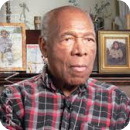 89. Like his contemporary Angelenos Charles Mingus and Dexter Gordon, Collette was an important part of the southern California jazz community long before the invention of the term West Coast Jazz. He played important roles in bands led by Benny Carter, Gerald Wilson, Chico Hamilton and Conte Candoli, among many others. He assembled a Charles Mingus big band that made a memorable impact at the Monterey Jazz Festival in 1964 and in succeeding years did the same for Dizzy Gillespie and Gil Evans. From Don Heckman's obituary of Collette in today's Los Angeles Times:
89. Like his contemporary Angelenos Charles Mingus and Dexter Gordon, Collette was an important part of the southern California jazz community long before the invention of the term West Coast Jazz. He played important roles in bands led by Benny Carter, Gerald Wilson, Chico Hamilton and Conte Candoli, among many others. He assembled a Charles Mingus big band that made a memorable impact at the Monterey Jazz Festival in 1964 and in succeeding years did the same for Dizzy Gillespie and Gil Evans. From Don Heckman's obituary of Collette in today's Los Angeles Times:
Collette's virtuosic skills on saxophones, flute and clarinet allowed him to move easily from studio work in films, television and recording to small jazz groups and big bands. He was, in addition, one of the activists instrumental in the 1953 merging of the then all-African American musicians union Local 767 and the all-white Local 47.
To read the complete obituary, go here.
Here is Collette playing unaccompanied alto saxophone.
Richard M. Sudhalter died two years ago today. A superb writer and musician, he was the author of the definitive biography of Bix Beiderbecke and played cornet—beautifully—in the Bix tradition. Here he is with the New York Jazz Repertory Company at a Town Hall concert in the early 1970s, playing Beiderbecke's "Davenport Blues." With him are Kenny Davern, bass saxophone; Bob Wilber, clarinet; Ephie Resnick, trombone; Marty Grosz, banjo; Chauncy Morehouse, drums; and Dill Jones, piano. The cornetist to Dick's left, paying close attention, is young Warren Vaché, Jr.
For an archive piece posted here when Dick Sudhalter died, and comments about him from Rifftides readers, go here.
Many of the numerous comments about my Bill Evans article in The Wall Street Journal this week have been touching. None has been more moving or more extensive than this one from Rifftides reader Mark Mohr. The staff agreed that Mr. Mohr's account of discovering Evans should be an item of its own because it parallels the experiences of so many other listeners.
I first saw Bill Evans in concert at the University of California at Santa Barbara in 1974. He and his trio (Eddie Gomez and Marty Morrell) were touring in support in the newly-released Fantasy album Since We Met. I was a fledgling disc jockey at the campus radio station, KCSB-FM. The station had made a serious commitment to extensive jazz programming, and I was just beginning to experience and enjoy jazz. There were quite a few students at the radio station who said a Bill Evans concert was not to be missed. I didn't know anything about Evans at the time but the station had received a few promo records and I seriously listened to Since We Met to find out what all the buzz was about. From the first note of the concert untilthe to the audience applause at the end, I was spellbound and struck by the quality of the music. Tender, sad, introspective and wonderful. I attended the Evans' concert at the university's Campbell Hall with some friends from the radio station. We had good seats and sat close to the stage. Evans, Morrell and Gomez walked out in matching slacks, dress shirts and sport coats. (It was the style at the time.) For the next forty-five minutes, the music and the musicians mesmerized me. I had never heard anything like it and I was hooked. At intermission, the radio boys and I went backstage and I nervously introduced myself to Bill and the other members of the trio. He was polite and friendly, but somewhat shy. The second half of the concert was even better than the first, if that's possible. Afterwards, the band left for their next gig in whatever town was next on their touring schedule.
The audience filed out and I went back to the radio station and replayed the album, listening even more closely. The next day, I found a few more Evans records in the station's library, and began to enjoy his earlier recordings. I told my parents about my extraordinary discovery and they wound up seeing him in concert a few weeks later at the Hollywood Bowl. I only saw him perform live once more, at the Catamaran Hotel in San Diego. It was four years later but by then, I had developed quite a collection of his records and later on I began collecting his CD's. His music always struck me as very, very special but I could never quite understand how such a talented musician and such a special man had fallen victim to drug use and abuse. This week marked the 30th anniversary of his passing. I've spent the past few days listening to a lot of his music, but I still think my all time favorite is Since We Met. My parents were deeply touched by his music, too. After they died, I spread their ashes into the Pacific Ocean at sunset and played some of their favorite Bill Evans music: "Seascape," "Dolphin Dance," "Peau Deuce" and fittingly, "I Will Say Goodbye." Bill Evans may be gone, but his music will live forever.
Edwin Newman's death at age 91 is not the end of an era. The broadcast news era that produced Newman ended long ago, as you may have noticed in most of the news programs you watch on television and, particularly, on cable. Newman worked for NBC News. He was of a generation of broadcast news people the best of whom applied the values of the wire services and newspapers where they learned the craft of journalism. 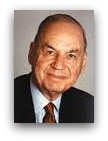 He was a splendid reporter who functioned as one of NBC's most productive, versatile and wise correspondents. He anchored newscasts, delivered commentaries and wrote and hosted documentaries. In his radio and television broadcasts, Newman often devoted segments to defending the correct use of the language and to witty, if unyielding, criticism of its butchery by those who should know better. He was disturbed by what he saw as the deterioration of the average American's ability to be articulate. He delighted in telling about the man he once interviewed whose answer to a question was, "Well, y'know, you never know, y'know?"
He was a splendid reporter who functioned as one of NBC's most productive, versatile and wise correspondents. He anchored newscasts, delivered commentaries and wrote and hosted documentaries. In his radio and television broadcasts, Newman often devoted segments to defending the correct use of the language and to witty, if unyielding, criticism of its butchery by those who should know better. He was disturbed by what he saw as the deterioration of the average American's ability to be articulate. He delighted in telling about the man he once interviewed whose answer to a question was, "Well, y'know, you never know, y'know?"
A few video clips exist of Ed Newman at work. YouTube has a series of pieces from the documentary he did about the 1964 World's Fair in New York and a few audio segments of his interviews with Marshall McLuhan about language. I thought about showing you one of those lighter pieces, but decided to instead use the commentary Newman delivered on the day in 1963 when President Kennedy was assassinated. The elegance of his language and the clarity of his thought are as vivid and pertinent now as they were 47 years ago.
Edwin Newman, RIP
A dyslexia attack a week ago caused the Rifftides proprietor to alert readers to a radio broadcast last Sunday that, in fact, will take place this coming Sunday, September 19. The only way to make amends is to correct the mistake and post the item again. The entire Rifftides staff is on vacation this week, more or less, but this may give the impression that we're on the job.
On his Jazz Northwest program this weekend, Jim Wilke will be playing the Ingrid Jensen-Benny Green concert that he recorded at the Port Townsend Festival in July. The trumpeter and the pianist appeared with drummer Jon Wikan, Dawn Clement on Fender Rhodes piano and bassist David Wong. According to Wilke's alert to the broadcast, the band "brought the near capacity crowd to its feet at the end of the concert."
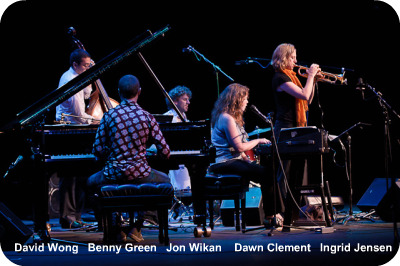
I wasn't at Port Townsend this year, but the audience reaction Jim describes is no surprise. Three years ago, at The Seasons in Yakima, Washington, I heard what I think was Jensen's and Green's first joint appearance. This is some of what I posted shortly after.
When I arrived home after a post-concert hang late Saturday night, I found this message from a musician friend:Has there ever been a better concert at the Seasons than the Ingrid Jensen one this evening?No. I have attended most of the jazz and classical events at The Seasons in its nearly two years of operation. I have heard wonderful performances in that former church, with its dramatic domed space and nearly perfect acoustics, but none better than when Jensen, the gifted Canadian trumpeter, and pianist Benny Green got together in a one-off collaboration. Creative sparks flew.
It is impossible to analyze with accuracy what is responsible for a performance that rises above even the usual excellence of artists of the quality of Jensen, Green, Jon Wikan and Russ Botten. I have a notion that what fired it up in this instance was the depth and unusual makeup of Green's accompanying chords in the first piece, and the way he applied them rhythmically. The harmonic changes in his comping stimulated Jensen to daring ideas that she incorporated in long, flowing melodic lines through the entire concert. The range and virtuosity of her trumpet and flugelhorn playing are givens. What I am emphasizing is the lyric and melodic content of her improvisations.
To read all of the July, 2007, Rifftides review, go here.
I have no idea whether their 2010 encounter reached those heights, but I wouldn't miss the opportunity to find out. Jazz Northwest will air at 1 o'clock PDT Sunday afternoon, September 19, on KPLU-FM (88.5) in the Seattle Tacoma area. For internet listeners, it will stream live on the station's website. Click on "Listen Now."
First of all, I never strive for identity. That's something that just has happened automatically as a result, I think, of just putting things together, tearing things apart and putting it together my own way, and somehow I guess the individual comes through eventually.
Especially, I want my work - and the trios if possible - to sing.
It bugs me when people try to analyze jazz as an intellectual theorem. It's not. It's feeling.
In today's Wall Street Journal I have an article in observance of the 30th anniversary of Bill Evans' death. Here are a few of the 900-plus words:
Among pianists, Evans, who died 30 years ago Wednesday at age 51, is as immediately identifiable as Tatum, Earl Hines, Teddy Wilson and Bud Powell. In artistry and influence, he is their inheritor and successor. With the exception of those who specialize in stride or boogie woogie, virtually all jazz pianists who developed from the early 1960s on learned from Evans and, if they could, adapted aspects of his playing.
To read the entire piece, open your WSJ to the Personal Journal section, or go here.
As a bonus for Rifftides readers, here's an account from Take Five: The Public and Private Lives of Paul Desmond of the night Evans asked Desmond to sit in.
(Desmond) and I went one evening to a club called Reno Sweeney to hear Bill Evans, who, it could be argued, was the most influential and respected jazz pianist since Bud Powell. Evans was appearing with his trio opposite Blossom Dearie. During a break, he joined us at our table to chat and said he would love it if Paul sat in. Desmond declined. Bill tried to persuade him. I offered to take a cab uptown and bring back his horn. "No, not tonight, thanks," Paul said. "Gee," Bill said, almost pleadingly, "Lee sat in last night." The news about Lee Konitz, whom Paul admired, did not change his mind.
I can't tell you how many times I've imagined the music those two would have made together.
Dominick Farinacci, Sounds In My Life (Keystone). When I first heard Farinacci five or six years ago, he was one of two trumpet students featured on a Warren Vaché instructional DVD. In his solo on a blues, I was intrigued that he seemed to be reflecting in a personal way a school of trumpet 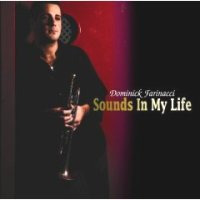 playing notable for the subtlety of its beauty. Some of the trumpeters in the 1950s whose characteristics of tone, fluidity of ideas and lyricism bound them together in a general style were Don Joseph, Tony Fruscella, Chet Baker and Miles Davis. As on-the-sleeve virtuosity has burgeoned, it is an approach to the trumpet that has become increasingly rare. When Farinacci's Sounds In My Life showed up in the mail, I put in on the CD player anticipating that kind of playing. I cannot report that I am disappointed that he was playing differently; his work is gorgeous.
playing notable for the subtlety of its beauty. Some of the trumpeters in the 1950s whose characteristics of tone, fluidity of ideas and lyricism bound them together in a general style were Don Joseph, Tony Fruscella, Chet Baker and Miles Davis. As on-the-sleeve virtuosity has burgeoned, it is an approach to the trumpet that has become increasingly rare. When Farinacci's Sounds In My Life showed up in the mail, I put in on the CD player anticipating that kind of playing. I cannot report that I am disappointed that he was playing differently; his work is gorgeous.
Farinacci's generous tone is open throughout the horn's register, with no sign of strain to reach top notes. At his most original, his ideas are intriguing. By 2007, when this was recorded, however, he had moved on from the Fruscella-Joseph-Baker-Davis approach to harder facets more akin to Blue Mitchell, Freddie Hubbard and the Miles Davis of the sixties. His work on two Jimmy Heath pieces is notably reflective of Mitchell, and no Mitchell admirer can complain about Farinacci's solo on "Mona's Mood." I am slightly troubled that a soloist of Farinacci's evident abilities chooses to perform virtual approximations of muted Davis in "Flamenco Sketches" and "My Funny Valentine." Davis did it brilliantly, so brilliantly that his muted work has been imitated for decades and has become a cliché. On open horn, Farinacci summons mid-sixties Davis in the opening out-of-tempo section of "What is This Thing Called Love," but in the main body of his solo works his way into what the old-timers used to call original stuff. His exposition of the melody of "I Can't Get Started" has intimations of Clifford Brown's control and Brown's use of grace notes, with improvisation in the solo that has a fine combination of elegance and passion.
Farinacci is still in his twenties and has recorded several other albums. I will seek out the others and follow his development with interest in the assumption that he is going through a period of assimilation and will come out of it with stronger indications of the individuality I heard in those few blues choruses on that Vaché DVD.
The US distributor of Sounds In My Life reports that the CD is out of stock, but this web site lists it at a bargain price.
Hey, I'm supposed to be on vacation this week. Look for further posts as they happen—and they may.
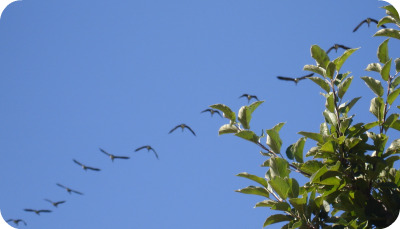
Tenor saxophonist Hadley Caliman died Wednesday in Seattle. He was 78 and had liver cancer. Until a few weeks before his death, Caliman thrived in the Pacific Northwest, starring in the Seattle Repertory Jazz Orchestra and leading his own group. Here, we see him soloing with the SRJO.
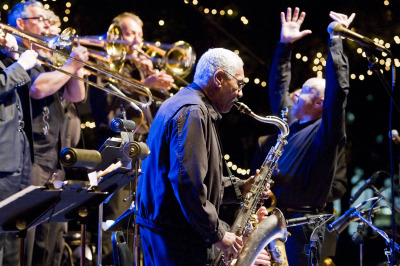
I wrote in Jazz Matters about Caliman in a 1979 performance with Freddie Hubbard's band:
As the evening progressed, Caliman's playing took on much of the intensity and coloration of John Coltrane's work, but he is a more directly rhythmic player than Coltrane was toward the end of his life and from that standpoint is reminiscent of his mentor Dexter Gordon. He made his first records in Los Angeles in 1949 when he was 17 and a student of Gordon. Whatever his influences, Caliman is an inventive and cheerful soloist.
After college, he went on to record extensively and work with musicians as varied as Gerald Wilson, Don Ellis, Hubbard, Santana and The Grateful Dead. Caliman retired in the mid-2000s as a music educator at Seattle's Cornish College of the Arts but not as a tenor saxophonist. In his final years he still sounded cheerful and at least as inventive as during his heyday (he made his first records in Los Angeles in 1949 when he was seventeen and a student of Gordon).
For an obituary of Caliman in a newspaper near the small town where he lived for several years, go here.
This video, unfortunately truncated, captures Caliman last July at Jazz Alley in Seattle with Thomas Marriott, trumpet; Bill Anschell, piano; Phil Sparks, bass; Matt Jorgensen, drums; and vocalist Gail Pettis. Jim Wilke does the introduction. The evening was a celebration of Caliman's 65th year as a professional musician.
The siege of deadlines has lifted. The assignments were good for the sagging exchequer but put the blogging account in arrears. In the days remaining before the staff goes on vacation, we'll pay attention to a few recent CDs.
Denny Zeitlin, Precipice (Sunnyside). Following Mosaic's release last year of a box of his Columbia recordings of the 1960s and a new trio album with Buster Williams and Matt Wilson, the protean pianist goes solo. He played this concert in a Santa Barbara hall with a fine Steinway and acoustics worthy of the instrument. I can't recall hearing Zeitlin's nuances with greater clarity. For that matter, I can't recall more of them. The title tune lives up to its name as it switches time signatures—or sets them aside for a while—and progresses through rhythms that stomp, dance and float. It's Zeitlin at his most orchestral.
this concert in a Santa Barbara hall with a fine Steinway and acoustics worthy of the instrument. I can't recall hearing Zeitlin's nuances with greater clarity. For that matter, I can't recall more of them. The title tune lives up to its name as it switches time signatures—or sets them aside for a while—and progresses through rhythms that stomp, dance and float. It's Zeitlin at his most orchestral.
He comes closest to the edge of the precipice in the relatively uncomplicated "Oleo." Many listeners first became aware of Zeitlin through his solo on that "I Got Rhythm" contrafact in a 1963 album with flutist Jeremy Steig. Down the years he has continued to play it. Familiarity with tunes doesn't breed contempt in jazz musicians, it breeds speed. Tunes have been known to reach velocities so high that their players fly out of control. Despite the tempo (eight choruses in two minutes and 47 seconds), not only is Zeitlin not thrown off, but he remains fully in charge for the whole ride. At a metronome setting of 310, you don't get profundity. You get exhilaration. In this case, the bozos in the audience who whooped and hollered after every tune were justified.
Zeitlin also revisits another of his favorites, "What is This Thing Called Love," at a relaxed tempo with altered harmonies that never occurred to Cole Porter and arpeggios that amount to Coltrane-like scales. Appropriately, he melds into Coltrane's "What is This..." variant "Fifth House," which has its own transformation of Porter's famous chord sequence. With the free improvisation that precedes it, the blended piece runs more than 12 minutes and feels half that long. Other highlights: Zeitlin's muscularity, technical control and dynamic range in Wayne Shorter's "Deluge" and his own "On the March;" his 5/4 flirtation with Rodgers' and Hammerstein's waltz "Out of My Dreams;" the tenderness of "The We of Us" and "Love Theme From Invasion of the Body Snatchers." Zeitlin wrote the score for that 1978 film. I haven't seen the movie. On the basis of its enchanting theme, it is on my list.
Zeitlin has divided his recorded work in the modern era more or less evenly between trio and solo albums. Those who have granted his trio albums the upper hand might do well to pay close attention to this one. It is in a league with his celebrated 1993 Maybeck performance, whose "What is This Thing Called Love/Fifth House" makes for interesting comparison with this new one.
More catching-up coming soon.
In the beginning, Stash Records specialized in songs from the '20s, '30s and '40s that dealt with drugs and sex. The first Stash compilation of old recordings, in 1976, was called Reefer Songs. Another of the label's big sellers was Copulatin' Blues. Eventually, founder Bernie Brightman, began making original recordings by jazz artists, including singer Chris Connor and pianist Hilton Ruiz. To his eternal credit (he died in 2003), Brightman also recorded two albums by Anita Gravine, an artist whose talent justifies wide fame but who has remained an insiders' favorite. Here is my mini-review of one of her Stash LPs, from the July, 1986 issue of Texas Monthly.
Anita Gravine, I Always Knew (Stash ST 255). An experienced but little-known singer whose second album is even better than her first, Gravine handles both ballad and up-tempo songs with ease of voice production and rhythmic assurance. Mike Abene's arrangements are stimulatingly unclichéd. The album is further graced by the trumpet solos of Tom Harrell. All of the above outdo themselves on a wonderful fugitive from the forties, "The Coffee Song."
Before you listen to "The Coffee Song," you should know that the all-star rhythm section is Abene, piano; George Mraz, bass; and Billy Hart, drums. The strings are led by the amazing Harry Lookofsky. Harrell solos majestically over Abene's rich carpet of dissonance. The arrangement led composer and arranger Bill Kirchner to call this "Bartók Goes to Brazil." If you're trying to stay awake, this is better than caffeine.
My research indicates that Stash Records no longer exists. Neither of Gravine's Stash albums made it to CD, although two of her later albums have. Her Stash LPs are around but hard to find. If you're interested in I Always Knew, you might try this website or this one.
As the 30th anniversary of Bill Evans' death approaches, he is on many minds. I am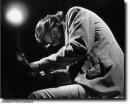 preparing a piece that will run the week of the date he died, September 15. As I researched it, among the Evans posts I found buried in the Rifftides past is one from four years ago. In those primitive days, the staff had yet to learn how to embed video. All we could do was provide a link to a rare performance of Evans and Kenny Burrell in duo. Now, we bring it to you direct as part of this encore post.
preparing a piece that will run the week of the date he died, September 15. As I researched it, among the Evans posts I found buried in the Rifftides past is one from four years ago. In those primitive days, the staff had yet to learn how to embed video. All we could do was provide a link to a rare performance of Evans and Kenny Burrell in duo. Now, we bring it to you direct as part of this encore post.
Evans And Burrell (October 19, 2006)
As far as I knew until today, Bill Evans and guitarist Kenny Burrell recorded together only once, on Evans' 1978 Quintessence session, which also included tenor saxophonist Harold Land, bassist Ray Brown and drummer Philly Joe Jones. The resourceful Jan Stevens of The Bill Evans Web Pages has pointed the way to another collaboration between Evans and Burrell, at the 1978 Montreux Jazz Festival. They played Thad Jones' "A Child is Born," one of the tunes from Quintessence. Evans was rarely caught smiling on camera, but he smiled radiantly—and for good reason—as he and Burrell finished a notably sensitive performance.
The Detroit Jazz Festival runs through the Labor Day weekend, with an impressive array of musicians including Roy Haynes, Maria Schneider, Terence Blanchard 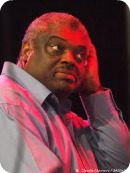 and Branford Marsalis. The festival's artist-in-residence, Mulgrew Miller, received advance attention from Detroit Free Press music critic Mark Stryker.
and Branford Marsalis. The festival's artist-in-residence, Mulgrew Miller, received advance attention from Detroit Free Press music critic Mark Stryker.
...the brightest spotlight falls on the Mississippi-born Miller, who makes four major appearances. He leads his sextet called Wingspan, plays duets with fellow pianist Kenny Barron, joins bassist Robert Hurst's quartet and appears opening night with the neo-gospel vocal ensemble Take 6. He'll also make a couple of other cameo appearances.
Miller is a good match for Detroit. He's not so much a star as a blue-collar hero, known for his versatility, collegiality and consistency: an aesthetic kin to the many jazz musicians from Detroit who are better classified as profound stylists and craftsmen than innovators. Miller long ago forged his influences, especially McCoy Tyner, Herbie Hancock, Chick Corea and Wynton Kelly, into an individual identity.
To read the whole thing, go here.
A few years ago (23), I wrote the liner notes for the Mulgrew Miller album Wingspan, which featured Kenny Garrett and Steve Nelson. Still fresh and undated, it is one of Miller's best. The LP and CD versions have become expensive collectors items, but it seems to be available as an MP3 download without necessitating a second mortgage. Shortly after he recorded Wingspan, Miller became a leader with a debut gig at the Village Vanguard. He has been one ever since, at the head of—what else?— Wingspan. It is good to see a prestigious festival like Detroit's recognizing so admirable a musician.
Bill Kirchner sent a link to a video. He accompanied it with a succinct message:
Play this when you're having a bad day.
I wasn't having a bad day, but the Thad-Jones Mel Lewis band made it better. This is from a European tour probably in the fall of 1969—not '68, as YouTube says.
The reed section: Joe Henderson, Jerry Dodgion, Jerome Richardson, Eddie Daniels, Pepper Adams.
Trumpets: Snooky Young, Danny Moore, Al Porcino, Richard Williams.
Trombones: Eddie Bert, Astley Fennell, Jimmy Knepper, Cliff Heather.
Rhythm: Mel Lewis, drums; Roland Hanna, piano; Richard Davis, bass.
Conductor: Thad Jones.
Be alert for the shot of Snooky at 2:35, enjoying Hanna's three-minute piano introduction. Who wouldn't?
While I'm wrestling the deadline monster (So far, I've got him two falls out of three), the least I can do is attempt to keep you entertained. If this doesn't do it, see your psychiatrist.
AJ Ads
AJ Blogs
AJBlogCentral | rssculture
Terry Teachout on the arts in New York City
Andrew Taylor on the business of arts & culture
rock culture approximately
Laura Collins-Hughes on arts, culture and coverage
Richard Kessler on arts education
Douglas McLennan's blog
Dalouge Smith advocates for the Arts
Art from the American Outback
Chloe Veltman on how culture will save the world
For immediate release: the arts are marketable
No genre is the new genre
David Jays on theatre and dance
Paul Levy measures the Angles
Judith H. Dobrzynski on Culture
John Rockwell on the arts
innovations and impediments in not-for-profit arts
Jan Herman - arts, media & culture with 'tude
dance
Apollinaire Scherr talks about dance
Tobi Tobias on dance et al...
jazz
Howard Mandel's freelance Urban Improvisation
Focus on New Orleans. Jazz and Other Sounds
Doug Ramsey on Jazz and other matters...
media
Jeff Weinstein's Cultural Mixology
Martha Bayles on Film...
classical music
Fresh ideas on building arts communities
Greg Sandow performs a book-in-progress
Harvey Sachs on music, and various digressions
Bruce Brubaker on all things Piano
Kyle Gann on music after the fact
Greg Sandow on the future of Classical Music
Norman Lebrecht on Shifting Sound Worlds
Joe Horowitz on music
publishing
Jerome Weeks on Books
Scott McLemee on books, ideas & trash-culture ephemera
theatre
Wendy Rosenfield: covering drama, onstage and off
visual
Public Art, Public Space
Regina Hackett takes her Art To Go
John Perreault's art diary
Lee Rosenbaum's Cultural Commentary
